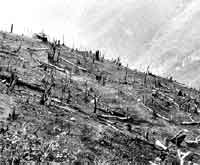Forest guardians
 forests are central to the people of Mizoram and are therefore an important determinant of the quality of their life. The book surveys the environmental history and the complex relation between the people and nature in Mizoram through the colonial, post-independence and the present times.
forests are central to the people of Mizoram and are therefore an important determinant of the quality of their life. The book surveys the environmental history and the complex relation between the people and nature in Mizoram through the colonial, post-independence and the present times.
The forest area is delineated into village, unclassified, reserved, protected and national parks and sanctuaries. The delineation of forests has been in existence much before the forest department was set up in 1972 in the state.
The forest department manages about 45.82 per cent of the total forest area, which includes national parks, sanctuaries, protected and reserved forest areas. The district council manages about 5.66 per cent and the democratically-elected village councils about 48.52 per cent, which includes unclassified forests. A unique feature of Mizoram is that a large percentage of forests are still managed by the village councils.
But over the years, forest management systems in Mizoram have undergone several changes. With the advent of the British, the village chiefs who managed the village affairs and forest use were replaced by the government agents.
There are several misconceptions about forest activities in Mizoram. For example, Jhum cultivation, which is the backbone of the agricultural economy of Mizoram, is embroiled in controversy. Unlike the planners and administrators, the author questions the dominant view that Jhum cultivation is an ecologically destructive occupation.
Jhum cultivation in Mizoram is carried out in unclassified forest area where Jhum plots are allotted to individuals by the village council. The council supervises and regulates some of the main operations within Jhum cultivation, such as clearing of trees.
While the Jhum cycle varies from village to village, a cycle is that of 7.32 years on an average despite the population growth in the state. Further, the percentage of recorded Jhum lands over the years has shown a decrease as people have shifted to urban centres. When compared to the rest of the land use systems in the hills, Jhum cultivation is seen as least liable to soil and water erosion or loss.
However, the government has been framing its earlier and the new land use policies ( nlup ) for the region with scant respect for Jhum cultivation. Schemes have been formulated in such a way that people have to give up their way of life. In a bid to stop Jhum cultivation, the government is introducing privatisation of land. Administrative pressures are being mounted, and place individual interests ahead of those of the community. Through nlup , incentives are being given to those who would give up Jhum cultivation and change over to animal husbandry, vegetable gardening and industry.
The nlup operates in such a way that it dislocates the well organised system of Jhum cultivation (which continues in practice covertly) and the system of village council which makes people accountable for their actions. In negating the authority of the village council over the issues of land use and management, the nlup disables the very institution which has been instrumental in effective administration of the natural resources in the region. Divested of its powers and superseded by the bureaucracy, the village council is today in danger of becoming a mere figurehead.
However, this criticism of the nlup does not mean that search for alternatives to Jhum cultivation should be stopped, says the author. She argues that the principal flaw in the system of shifting cultivation is that far more remunerative options exist in the present technological and economic situation. Communities and individuals who fail to grasp these options are running the risk of rapid economic, social and political marginalisation.
The real challenge is whether people can set their own terms for any change rather than being compelled by forces beyond their control. This would require the reversal of the increasing tendency to marginalise people-based institutions which should be reinforced so that they can help people adapt to the changing conditions. Drawing the readers' attention to the community-based decision-making structures in Mizoram, the author concludes that the experience of village councils in regulating the use of forest resources in Mizoram has much to offer in the current debate over greater devolution of powers to local institutions.
Related Content
- Falling short: Donor funding for Indigenous Peoples and local communities to secure tenure rights and manage forests in tropical countries (2011–2020)
- Forest governance by indigenous and tribal peoples. an opportunity for climate action in Latin America and the Caribbean
- Damning logging report finds Victorian department neither 'effective nor respected'
- Analysis warns of lack of progress on 2020 global emissions target
- Americans’ climate change concerns surge to record levels, poll shows
- Climate report Trump tried to bury: key findings No 1 – air pollution kills
